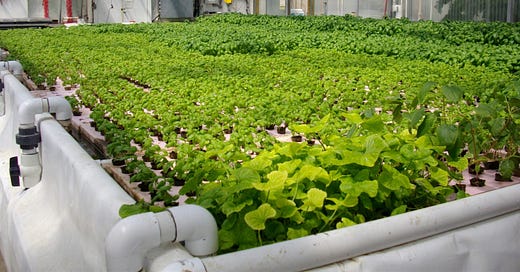Thirty years ago aquaponics were the next best thing. They still are.
Why is this efficient and sustainable food production method still only generating a fraction of our food?
I remember reading about aquaponics way back in the eighties. Just about every article extolled the promises of aquaponics and predicted that much of our food would be produced this way in the near future. More than 40 years later, that near future is now, yet aquaponics remains a niche way of producing food.
The aquaponics market is projected to provide only a fraction of our food in the United States: $1.21 billion in a food industry that totals about $1.5 trillion. That’s about one-tenth of one percent of the entire market. Why isn’t more food produced from something that has been so promising for so long?
Hydroponics and aquaponics
Hydroponics is the cultivation of plants in water that has been enriched with nutrients. Aquaponics takes hydroponics a step further, adding fish to the water. Nutrients that would be added to the water in a hydroponic system are provided by the fish from their waste. More food is produced with aquaponics, as both vegetables and fish can be harvested. As such, it is considered one of the most efficient and environmentally sustainable food production methods.
There is evidence that the Aztecs practiced aquaponics a thousand years ago. They covered rafts with soil and planted crops in these “floating farms.” Modern aquaponics production usually occurs in greenhouses and has been around for over 40 years. In the 1970s, an organization established to develop sustainable living strategies, the New Alchemy Institute, partnered with Solsearch Architects to create the “Ark,” a home on Prince Edward Island that included a fish and vegetable cultivation system. The first successful closed-loop aquaponics were created at North Carolina State University in the 1980s.
At about the same time, Dr. James Rakocy researched aquaponics while completing his Ph.D. at Auburn University. He created a micro-ecosystem in which the waste from fish provided fertilizer for plants. Rakocy went on to create the first commercially viable aquaponics system at the University of the Virgin Islands in the 1980s.
The good, the bad, and the aphids
Recent research backs up aquaponics’ promise of higher yields. Scientists grew pumpkins aquaponically and found the yield to be five to eleven times higher than pumpkins grown on land, and fish production in aquaponics was 29 to 75 percent greater than other aquaculture methods. After their initial setup, aquaponic systems need less manual labor than traditional farming. Other advantages are reduced pollution from nutrient runoff from fields and reduced energy consumption.
Keep reading with a 7-day free trial
Subscribe to The Green Dispatch to keep reading this post and get 7 days of free access to the full post archives.



